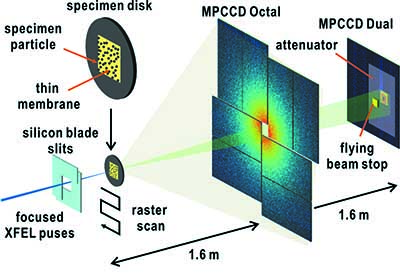Cryogenic coherent X-ray diffraction imaging of biological cells by X-ray free-electron lasers
 Coherent X-ray diffraction imaging (CXDI) has been used to visualise the internal structures of non-crystalline particles with dimensions of micrometers to sub-micrometers in materials science and biology.
Coherent X-ray diffraction imaging (CXDI) has been used to visualise the internal structures of non-crystalline particles with dimensions of micrometers to sub-micrometers in materials science and biology.
Now X-ray free-electron lasers (XFELs) are leading CXDI to a new levels. X-ray pulses with complete spatial coherence and duration are available at XFEL Facilities such as the Linac Coherent Light Source (LCLS) and the Spring-8 Angstrom Compact Free-Electron Laser. One can routinely collect diffraction data before radiation-damage processes occur and owing to the repetition rate of XFEL pulses, a large number of diffraction patterns can be collected within a short period of time.
A group of scientists [Kobayashi et al. (2016), J. Synchrotron. Rad. 23, doi:10.1107/S1600577516007426] have recently proposed XFEL-CXDI experiments for frozen-hydrated biological specimens at cryogenic temperatures. It has been demonstrated previously that cryogenic technologies enable the storage of biological cells at low temperatures, for instance in medical science. Frozen hydrated cells and cellular organelles keep their functional structures, and are still alive after returning to ambient temperatures.
Cryogenic sample preparation enables the storage of frozen-hydrated specimens in liquid nitrogen for CXDI experiments, scientists can therefore harvest a large numbers of cells and isolated unstable cellular organelles at a desired period of the cells cycle. Moreover, frozen-hydrated specimens are free from adiabatic expansion, bubbling of water inside biological specimens and other phenomena.
The scientists have developed membranes, devices and procedures to prepare frozen-hydrated biological specimens and standard specimens for cryogenic XFEL-CXDI experiments. The quality of the prepared specimens was examined through a series of diffraction experiments and based on the results, the researchers discussed future developments in specimen preparation, and the characteristics of frozen-hydrated biological specimens in CXDI experiments.

